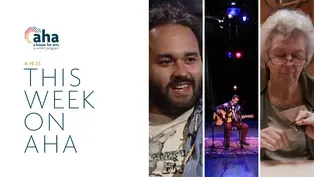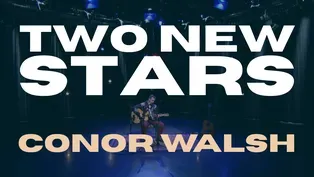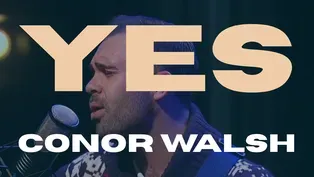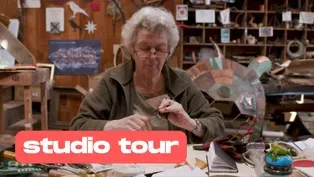
The Collaborative World of Artist Natan Diacon-Furtado
Clip: Season 8 Episode 25 | 12m 17sVideo has Closed Captions
Discover the unique collaborative approach of artist and designer, Natan Diacon-Furtado.
Sit down with Natan Diacon-Furtado, a collaborative artist and designer who brings together his background in cultural anthropology and architecture to create unique projects that connect him to new experiences and communities.
Problems with Closed Captions? Closed Captioning Feedback
Problems with Closed Captions? Closed Captioning Feedback
AHA! A House for Arts is a local public television program presented by WMHT
Support provided by the New York State Council on the Arts (NYSCA), M&T Bank, the Leo Cox Beach Philanthropic Foundation, and is also provided by contributors to the WMHT Venture...

The Collaborative World of Artist Natan Diacon-Furtado
Clip: Season 8 Episode 25 | 12m 17sVideo has Closed Captions
Sit down with Natan Diacon-Furtado, a collaborative artist and designer who brings together his background in cultural anthropology and architecture to create unique projects that connect him to new experiences and communities.
Problems with Closed Captions? Closed Captioning Feedback
How to Watch AHA! A House for Arts
AHA! A House for Arts is available to stream on pbs.org and the free PBS App, available on iPhone, Apple TV, Android TV, Android smartphones, Amazon Fire TV, Amazon Fire Tablet, Roku, Samsung Smart TV, and Vizio.
Providing Support for PBS.org
Learn Moreabout PBS online sponsorship- I want to know what led you into the arts?
How did you become Natan the artist?
- Oh, that's a sweet question.
Well, I think I've been in the arts my whole life.
My mom's a conceptual artist.
My dad's a cultural historian and a historian of Latin America, and so that also sort of looks at arts, and so ever since I was born, as a kid, I would help my mom in the studio and be sort of like a studio assistant.
And then in school, I always sort of was drawn to art classes, and I'm just realizing now that kind of a lot of the foundational stuff that I was putting together like, "Oh, this makes me feel good" in this art class in middle school, and like, "Oh, I've been thinking about combining, you know, this idea with this idea" in high school.
Like, all of a sudden now I'm actually going back and being like, "Whoa, I'm doing the same thing now, but now I actually know what I'm doing."
And so like, I feel like I've been in it my whole life, but every day is kind of this process of rediscovering why I go to art and why kind of live in art as a way of kind of processing my life and living through it day to day.
- Oh, so it seems like you kind of just grew up around it too.
- Yeah.
- I do love, like, my family is also full of artists as well and it is very inspiring and very nice to be around folks who have just created art since you were little wee baby to now.
- Yeah, and then they'll just roast you.
- Yeah, true.
(both laughing) The roasting never stops, I swear.
So how would you describe your work to someone who's unfamiliar?
- Yeah, so I start off by saying that I'm a collaborative artist and designer, and so that means that everything I do is open in a way that invites people to collaborate with it, whether it's by physically manipulating pieces, or by engaging with the archival process that creates those pieces, or just by sharing their stories that become part of the art.
And so that's through workshops, through printmaking, through sculpture making, and through installations mostly.
- Awesome, and any examples of like, any of your collaborative, I guess, projects that you've worked on with folks?
Just like one example so folks understand what a collaborative artist really is.
- Yeah, sure, a good example maybe is I basically have these series that continue as collaborations between lots of different folks.
So I have a series called "Our Patterns" that starts out as a pattern making workshop that can be, you know, from two hours to three weeks to three months, and it engages mostly with young adult students, and we come together to kind of create a shared visual language about our day-to-day life.
So it's just about kind of learning to talk to each other through visuals, and that project, what comes out of it is a shared visual language through a kind of a quilt of patterns.
And we use this kind of idea of a quilt as a way of saying, "Well, you can stitch everybody's individual thoughts and visions together as a way of kind of sharing and collaborating with each other."
So everybody gets to do their own thing, but you get to come together and see how it all relates.
- Oh, I like that.
- Yeah.
- I love the quilt method too.
So patterns seem to influence your work heavily, and I want to ask like, why is that, and what's the background of that?
- Well, I like to say that I engage with a globally southern heritage of pattern making as a language and art and a craft in all my work.
Most of that comes from the fact that I grew up sort of half the time in the US in the United States South in East Tennessee, and then the other half of the time in Brazil, especially in the capital city of Brazilia.
And growing up in Brazilia in particular, Brazilia is one of the few capital cities that is a totally modernist, and was built in 1952.
And part of this development of that city was that they actually designed a graphic system that could be used for sign making for all the buildings.
So without having to see a sign that says like, this is a bank or this is a church, just the tile patterns actually would tell you like, oh, you're in this neighborhood, you're in that neighborhood, you're at your bank, you're at your grocery store.
And so I just grew up with this idea that, oh, patterns have have meanings and patterns can connect people.
And then at the same time in the American South in East Tennessee, you grow up around a quilting tradition and around that idea of people coming together to make meaning through pattern.
And so for me, pattern making has just always been sort of a tertiary language with which I can understand and communicate with the rest of the world, and so that's why it's such an important part of what I do.
- And do you see pattern as language?
- Yeah, absolutely.
I think that for me especially, well, I think patterns are a language for everybody, and I think a lot of the work that I do, the collaborative element is about getting folks to understand that and sort of tap into this new language that they maybe didn't know that they had access to.
But for me in particular, I think of patterns as a way of tapping into languages that have been lost within me, within my ancestry, because of the history of colonialism and things like that, so for me, pattern making, again engaging with this globally southern heritage of language, art, and craft through these kind of like, simple geometric shapes that tell stories, I like to think of the way I use pattern making as engaging with all the languages that have been lost of all those people that sort of came before me, right?
And in that way I get to kind of recuperate that, but I also get to build on that, so it's looking forward and looking backwards at the same time.
- Oh, I love that, it's really beautiful.
- Yeah.
- Well, what kind of materials do you use, or what kind of, I guess, mediums that you work in?
- Yeah, so the number one criteria for a medium for me is that it's simple and it's inviting.
So it actually changes a lot, depending on what the project is and who I'm working with.
For me, every day, my medium is rubber stamp, ink, and paper, so I almost keep like, a diary of what I see during the day as like, stamp making.
So like for example, like the shape of this couch, like, I might just see sort of like the cut of that arm, and think, oh, that's a really interesting shape.
I'll turn it into a stamp, and then I'll kind of try to make some patterns with it as a way of keeping like, a visual diary of today, and that's my method to generate this kind of geometric language that I use in everything else, right?
In terms of ease, I think we sort of split off into digital methods particularly.
I do a lot of projection work.
Digital projections are great because they can be scaled at any size, and they can interact with all sorts of different things at these different scales.
So for example, a recent project here in Troy for Troy Glow, which was called "Our Patterns, our Architectures" projected patterns that were created with these really small archival photos from the Hart Cluett Museum.
Collaborated with them to kind of remix these photos into patterns that connected more to the culture as it is now in Troy, and then through projection was able to actually collaborate with these big buildings, historic buildings in Troy, right?
And so again, it's about how easy is it to get to that stage of getting to collaborate with somebody?
So digital projections are big, paper is big for me, and then in my sculpture work, I use a lot of metals and plastics and things like that.
- Oh, that's cool.
And when you said stamps, do you mean like you said, "Oh, I like that you know, shape on the couch."
Do you literally cut out a rubber stamp or what does that- - Yeah, again, it's about whatever's at hand and what's the easiest, right?
So my default is the, yeah, cut out a rubber stamp to make a pattern.
But you could also, and I like to tell people this, like, you can use whatever material is at hand, right?
So I also will just draw the shape of a stamp to create later, or like, you know, just imagine what it would look like if I did stamp on a piece of paper and just sketch that out, sketch the finished product out.
But the idea is that I'm creating a physical pattern, an actual pattern from a stamp, but the idea of pattern is beyond that, right?
It's also like, the different patterns of thought that I'm having during that day, or patterns of culture, patterns of work that we're interacting with throughout that time.
- Amazing Recent exhibits, I know you had a recent exhibit where you kind of showcased a lot of these patterns, and like, just cool ideas of ways to do things.
That was in Japan.
So I wanted to talk to you a little bit more about that exhibit in residency when you were in Japan a little bit.
- Yeah, thanks.
I recently had a solo museum show in Japan at the Aomori Contemporary Art Center.
It was called "Field Work at Aomori Contemporary Art Center Collaborative Exhibition Lab."
So we had to sort of give it a subtitle so that people knew that they could be invited in to actually engage with the work, and that in particular, again talking about using the simplest materials that invite people to feel safe and comfortable with engaging with the combined digital projection with actually sort of cardboard cutout sculptures.
And so the museum was filled with these cardboard cutouts that were based on stamp shapes, but were made three-dimensional, and visitors were allowed to move those around the space that had an immersive projection of patterns in it.
And so in building up the sculptures, visitors created their own sort of screens for these projections, and then the projections also bounced around the walls and around a water feature that was outside.
- And how did you get into that?
- Completely by chance.
(laughs) I'm a big fan of just sort of searching online and applying for things that feel right, even if you don't really know how they're gonna work out, right?
And so I got into doing that exhibit through an open call for a residency at ACAC, and they were in particular looking for an international resident who would work virtually, and because a lot of my collaborative projects during the pandemic had to be virtual, I kind of am really versed in being able to actually collaborate in a meaningful way across the computer screen and across a time divide.
And so for me, it was a really interesting and exciting thing to be like, "Okay, can we do this?"
I'm used to doing this like, across the coast, or like, in two different cities.
Can I actually do it in two different continents?
And it turns out we can, and it's like, totally wonderful, and it's an an amazing feeling when you're coming up with an idea and hoping that people engage with it, and then this exhibit opens up in a completely different place that you've never been to before, and people are engaging with it in ways you could never imagine, which is the goal.
- Yeah, it's everything every artist wants, right?
To be able to engage and communicate their art to others, and hope that others, you know, not hope that they do understand, but we like to have our audiences kind of gain something commutative or communal out of our pieces.
- Yeah, I mean, I think that in reality, I'm the one who gains, because a lot of these pieces are open-ended, and they're about allowing visitors to bring their own meanings to the work.
And so for this exhibit in Japan, what was completely amazing was just how much people brought from their own culture into it that had, I didn't put in at all.
And that's kind of the point is to be able to create pieces that are collaborative, that are open-ended so that they can mean so much to so many people.
- Yeah, that's great.
And one other thing, what inspires you?
Where do you get your inspiration from?
Where do you pull that from?
I know you have a background, I believe, in architects.
- That's right.
- So do you pull anything from that?
- Yeah, I'm originally trained as two things.
I'm originally trained as a cultural anthropologist, and then I went back to graduate school and I was trained as an architect, particularly in public interest design.
Architecture in particular trained me how to define space, and so a lot of my art is just about making space for people to come together and make meaning together.
I like to say that my practice is a couple of things.
It's a pattern making practice, it's a space making practice and it's a memory making practice, but all of that is in the service of collaborative meaning making.
And so architecture trained me to do that, to make a space and sort of get out of it so that people can fill it.
And then cultural anthropology, which is what I originally went to school for, trained me in a really interesting way to sort of be able to develop my own tools to kind of inquire why I do things, and in a lot of ways, my whole practice is based around trying to develop these collaborative tools that people can then use to kind of discover more about themselves and dig deeper into themselves.
- Oh, God, that's great.
Well folks, make sure you check out Natan's work, amazing artist.
Love the complexity, yet the simpleness of it at the same time, beautiful.
And thank you for stopping by to talk to us today.
- Thank you, Jade, this was awesome.
Video has Closed Captions
Preview: S8 Ep25 | 30s | Turning metal into art, the collaborative world of art & design, and Conor Walsh performs. (30s)
Conor Walsh: Live Performance of 'Two New Stars'
Video has Closed Captions
Clip: S8 Ep25 | 4m 5s | Performance of Conor Walsh's 'Yes' from his 2022 album, Always & Forever. (4m 5s)
Conor Walsh: Live Performance of 'Yes'
Video has Closed Captions
Clip: S8 Ep25 | 3m 13s | Performance of Conor Walsh's 'Yes' from his 2022 album, Always & Forever. (3m 13s)
Transforming Scrap into Gold: The Art of Robin Tost
Video has Closed Captions
Clip: S8 Ep25 | 6m 3s | Witness Robin Tost's extraordinary talent of turning scrap metal into fine art. (6m 3s)
Providing Support for PBS.org
Learn Moreabout PBS online sponsorshipSupport for PBS provided by:
AHA! A House for Arts is a local public television program presented by WMHT
Support provided by the New York State Council on the Arts (NYSCA), M&T Bank, the Leo Cox Beach Philanthropic Foundation, and is also provided by contributors to the WMHT Venture...















